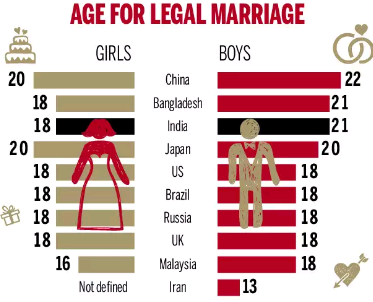Focus: GS-II Social Justice
Introduction
- The government’s decision to reconsider the minimum age of marriage for women is a step welcomed by many.
- Currently pegged at 18 years for women and 21 for men, the minimum age of marriage is a product of personal laws that mostly do not have equal rights for women.
- For Hindu women, the change from child marriage being a norm to outlawing it has been an arduous fight against religious and social conservatives.
How age limits came to be where they are now?
- The Indian Penal Code in 1860 criminalised sexual intercourse with a girl below the age of 10, introducing the first legal framework for a minimum age of consent for girls.
- Increasing the age by even just two years to 12 in the Age of Consent Bill in 1927 was opposed by many nationalists who saw the move as imperial interference with local customs.
- In 1929, the barrier was further raised to outlaw marriage of girls below 16.
- From then, it took nearly five decades to bring the law to its current standard of 18 years for women and 21 for men.
Reasoning
There are two crucial reasons that make it necessary to update the law again:
I- Improve Female Health
- According to a United Nations Population Fund report, India is home to one in three child brides in the world.
- Early marriages causing early pregnancies are inherently linked to higher rates of malnourishment, maternal and infant mortality.
- Although maternal mortality rate has been declining, the move to increase the minimum age of marriage could boost the fight.
II- Keeping up the promise of equality made to women under the Constitution
- There is no reason why the law makes the presumption that the minimum age of marriage must be different for men and women.
- It perpetuates benevolent sexism or the stereotype that women are more mature and therefore, can be given greater responsibilities at a younger age in comparison to men.
- The reflection of patriarchy in personal laws must change to fit the framework of the Constitution.
Conclusion
- Despite the well-intended reasons, a change in law may not suffice in ending discrimination against women.
- Policymakers will do well to delink age of marriage and age of sexual consent as teen pregnancies happen outside of marriage too.
- Laws that prevent child marriages and sexual exploitation of minors must be implemented effectively.
- Without improving other welfare mechanisms including educational and employment opportunities for women, the increase in age of marriage will only delay the problem and not remedy it.

-Source: Indian Express



